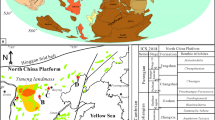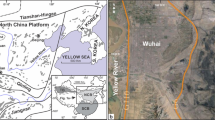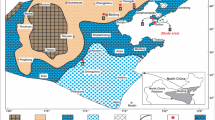Abstract
Oolitic shoals widely developed in the North China Platform during the Cambrian Miaolingian Epoch, which coincided with the first episode of cyanobacterial calcification. This study reports the co-occurrence of oncoids with ooids in the carbonate sedimentary environment in four different sections. A comprehensive study involving outcrop description, microscopic observation and statistical analysis is carried out to determine the facies, morphology and internal structure of both oncoids with ooids. Field observations show that the co-occurrence of oncoids and ooids developed at the top part of the third-order depositional sequence that represents the depositional products of the relative sea-level decline process. Microscopic observation shows that both oncoids and ooids can be subdivided into five types on the basis of their internal structure and morphological features. The comparative study of oncoids and ooids in different stages shows the influence of microbial activity on the formation of oncoids and ooids. Moreover, the comparison of oncoids from four different sections shows that the paleogeographic position and microbial involvement impacted the deposition and morphological diversity of carbonate grains in this period. In addition, the presence of microbial fossils and constructive micrite envelopes around these ooids confirm a participatory role of microbial mats in carbonate grain formation during the first episode of the cyanobacteria calcification event in the Cambrian.












Similar content being viewed by others
References
Peryt, T.M.: Classification of Coated Grains. In Biddle, K.T. Coated Grains. Springer, pp. 7–8. Berlin Heidelberg (1983)
Gerdes, G.; Dunajtschik-Piewak, K.; Riege, H.; Taher, A.G.; Krumbein, W.E.; Reineck, H.E.: Structural diversity of biogenic carbonate particles in microbial mats. Sedimentology 41, 1273–1294 (1994)
Davaud, E.; Girardclos, S.: Recent freshwater ooids and oncoids from western Lake Geneva (Switzerland): indications of a common organically mediated origin. J. Sediment. Res. 71(3), 423–429 (2001)
Suarez-Gonzalez, P.; Benito, M.I.; Quijada, I.E.; Mas, R.; Campos-Soto, S.: “Trapping and binding”: a review of the factors controlling the development of fossil agglutinated microbialites and their distribution in space and time - Sciencedirect. Earth Sci. Rev. 194, 182–215 (2019)
Xiao, E.Z.; Mei, M.X.; Jiang, S.; Zafar, T.: Morphology and features of Cambrian oncoids and responses to palaeogeography of the North China Platform. J. Palaeogeograp. 9(2), 150–167 (2020)
Xiao, E.Z.; Zafar, T.; Latif, K.; Riaz, M.; Lu, Y.: Geochemical and petrographic analyses of the Cambrian Oncoids of the North China platform: implications for their paleogeography and Paleoenvironment. Arab. J. Sci. Eng. 45(1), 307–325 (2020)
Suarez-Gonzalez, P.; Reitner, J.: Ooids forming in situ within microbial mats (Kiritimati atoll, central Pacific). Cold Spring Harbor Lab. 95, 809–821 (2021)
Xiao, E.Z.; Zafar, T.; Riaz, M.; Latif, K.; Setoyama, E.; Wang, H.; Xin, H.: Sequence stratigraphic and petrological analyses of the Cambrian oncoids exposed in the Liaoning Province, North China Platform. Aust. J. Earth Sci. 68(6), 868–885 (2021)
Riding R. Cyanoliths (Cyanoids): Oncoids Formed by Calcified Cyanophytes. In Biddle, K.T. Coated Grains. Springer, pp. 276–283. Berlin Heidelberg (1983)
Flügel, E.: Microfacies of Carbonate Rocks Analysis, Interpretation and Application. Springer, Berlin Heidelberg (2010)
Wang, H., Xiao, E.Z.: Oncolites in the Zhangxia formation of Cambrian series 3 at Diaoquan section in Lingqiu, Shanxi. Journal of Northeast Petroleum University. 42(5), 44–53(2018) (in Chinese with English abstract).
Sumner, D.Y.; Grotzinger, J.P.: Numerical modeling of ooid size and the problem of Neoproterozoic giant ooids. J. Sediment. Petrol. 63, 974–982 (1993)
Duguid, S.; Kyser, T.K.; James, N.P.; Rankey, E.C.: Microbes and Ooids. J. Sediment. Res. 80(3), 236–251 (2010)
Diaz, M.R.; Piggot, A.M.; Eberli, G.P.; Klaus, J.S.: Bacterial community of oolitic carbonate sediments of the Bahamas Archipelago. Mar. Ecol.-Prog. Ser. 485(27), 9–30 (2013)
Diaz, M.R.; Swart, P.K.; Eberli, G.P.; Oehlert, A.M.; Devlin, Q.; Saeid, A.; Altabet, A.M.: Geochemical evidence of microbial activity within ooids. Sedimentology 62(7), 2090–2112 (2016)
Brehm, U.; Palinska, K.A.; Krumbein, W.E.: Laboratory cultures of calcifying biomicrospheres generate ooids-A contribution to the origin of oolites. Carnets De Géologie. L3, 1–6 (2004)
Brehm, U.; Krumbein, W.E.; Palinska, K.A.: Biomicrospheres generate ooids in the laboratory. Geomicrobiol J. 23(7), 545–550 (2006)
Diaz, M.R.; Eberli, G.P.: Decoding the mechanism of formation in marine ooids: a review. Earth-Sci. Rev. 190, 536–556 (2018)
Batchelor, M.T.; Burne, R.V.; Henry, B.I.; Li, F.; Paul, J.A.: Biofilm and organomineralisation model for the growth and limiting size of ooids. Sentific Rep. 8(1), 1–9 (2018)
Xiao, E.Z.; Riaz, M.; Zafar, T.; Latif, K.: Cambrian marine radial Cerebroid ooids: participatory products of microbial processes. Geol. J. 56(9), 4627–4644 (2021)
Dupraz, C.; Reid, R.P.; Braissant, O.; Decho, A.W.; Norman, R.S.; Visscher, P.T.: Processes of carbonate precipitation in modern microbial mats. Earth-Sci. Rev. 96(3), 141–162 (2009)
Dai, M.Y.; Qi, Y.A.; Chang, Y.G.; Wang, M.; Li, D.: Oncoids and their significance from the second member of the Mantou formation (Cambrian Series 3), Dengfeng Area. Henan. Acta Sedimentologica Sinica. 32(3), 410–417 (2014)
Chelsea, L.P.; Donald, F.M.; James, S.K.; Peter, K.S.: Deposition and diagenesis of marine oncoids: implications for development of carbonate porosity. J. Sediment. Res. 85(11), 1323–1333 (2015)
Dylan, T.W.; Frank, A.C.; Nemanja, B.; Stephen, Q.D.; Tatsuo, O.; Sersmaa, G.: Punctuated growth of microbial cones within early cambrian oncoids, Bayan Gol formation, western Mongolia. Palaios 30(12), 836–845 (2015)
TałAnda, M.; Bajdek, P.; NiedźWiedzki, G.; Tomasz, S.: Upper Triassic freshwater oncoids from Silesia (southern Poland) and their microfossil biota. Neues Jahrbuch für Geologie und Paläontologie-Abhandlungen. 284(1), 43–56 (2017)
Mlewski, E.C.; Pisapia, C.; Fernando, G.; Lena, L.; Eliana, S.R.; Karim, B.; Bénédicte M, M.; StephanFrédéricMatthieu, B.J.R.: Characterization of Pustular Mats and Related Rivularia-rich Laminations in oncoids from the Laguna Negra Lake (Argentina). Front Microbiol. 9, 996–1019 (2018)
Mei, M.X.; Riaz, M.; Liu, L.; Meng, Q.F.: Oncoids build by photosynthetic biofilm: an example from the Series 2 of Cambrian at Fuzhouwan section in Liaodong Peninsula. J. Palaeogeogr. 21(1), 31–48 (2019)
Gradzinski, M.; Tyszka, J.; Uchman, A.; Renata, J.: Large microbial-foraminiferal oncoids from condensed lower-middle Jurassic deposits: a case study from the Tatra Mountains, Poland. Palaeogeogr. Palaeoclimatol. Palaeoecol. 213(1–2), 133–151 (2004)
Reolid, M.; Nieto, L.M.: Jurassic Fe-Mn macro-oncoids from pelagic swells of the external Subbetic (Spain): evidences of microbial origin. Geol. Acta 8(2), 151–168 (2010)
Védrine, S.; Strasser, A.; Hug, W.: Oncoid growth and distribution controlled by sea-level fluctuations and climate (Late Oxfordian, Swiss Jura Mountains). Facies 53(4), 535–552 (2007)
Nehza, O.; Woo, K.S.; Lee, K.C.: Combined textural and stable isotopic data as proxies for the mid-Cretaceous paleoclimate: a case study of lacustrine stromatolites in the Gyeongsang Basin SE Korea. Sedimentary Geol. 214(1–4), 85–99 (2009)
Védrine, S.: Co-occurrence of the foraminifer Mohlerina basiliensis with Bacinella-Lithocodium oncoids: palaeoenvironmental and palaeoecological implications (Late Oxfordian, Swiss Jura). J. Micropalaeontol. 27(1), 35–44 (2014)
Berra, F.; Felletti, F.; Tessarollo, A.: Oncoids and groundwater calcrete in a continental siliciclastic succession in a fault-controlled basin (Early Permian, Northern Italy). Facies 65, 38 (2019)
Zatoń, M.; Kremer, B.; Marynowski, L.; Wilson, M.A.; Wojciech, K.: Middle Jurassic (Bathonian) encrusted oncoids from the Polish Jura, southern Poland. Facies 58(1), 57–77 (2012)
Amao, A.O.; Al-Ramadan, K.; Koeshidayatullah, A.: Automated mineralogical methodology to study carbonate grain microstructure: an example from oncoids. Environ. Earth Sci. 75(8), 666 (2016)
Diaz, M.R.; Eberli, G.P.; Blackwelder, P.; Phillips, B.; Swart, P.K.: Microbially mediated organomineralization in the formation of ooids. Geology 45(9), 771–774 (2017)
Simone, L.: Ooids: a review. Earth Sci. Rev. 16, 319–355 (1980)
Woods, A.D.: Microbial ooids and cortoids from the Lower Triassic (Spathian) Virgin Limestone, Nevada, USA: evidence for an Early Triassic microbial bloom in shallow depositional environments. Global Planet. Change 105, 91–101 (2013)
Meng, X.H.; Ge, M.; Tucker, M.E.: Sequence stratigraphy, sea-level changes and depositional systems in the Cambro-Ordovician of the North China carbonate platform. Sed. Geol. 114, 189–222 (1997)
Feng, Z.Z.: Lithofacies Palaeogeography of the Cambrian and Ordovician in China. Petroleum Industry Press, Beijing (2004).
Ma, Y.S.; Mei, M.X.; Zhou, R.X.; Yang, W.: Forming patterns for the oolitic bank within the sequence-stratigraphic framework: an example from the Cambrian series 3 at the Xiaweidian section in the western suburb of Beijing. Acta Petrologica Sinica. 33(4), 1021–1036 (2017)
Latif, K.; Xiao, E.Z.; Riaz, M.; Wang, L.; Khan, M.Y.: Sequence stratigraphy, sea-level changes and depositional systems in the Cambrian of the North China Platform: a case study of Kouquan section, Shanxi Province China. J. Himalayan Earth Sci. 51(1), 1–16 (2018)
Riaz, M.; Xiao, E.Z.; Latif, K.; Zafar, T.: Sequence-stratigraphic position of Oolitic bank of Cambrian in North China Platform: example from the Kelan Section of Shanxi Province. Arab J Sci Eng. 44, 391–407 (2019)
Riaz, M.; Latif, K.; Zafar, T.; Xiao, E.Z.; Ghazi, S.; Wang, L.; Hussein, A.A.A.: Assessment of Cambrian sequence stratigraphic style of the North China Platform exposed inWuhai division. Inner Mongolia. Himalayan Geol. 40(1), 92–102 (2019)
Liu, W.; Zhang, X.L.: Girvanella-coated grains from Cambrian oolitic limestone. Facies 58(4), 779–787 (2012)
Meng, X.H.; Ge, M.; Tucker, M.E.: Sequence Sequence stratigraphy, sea-level changes and depositional systems in the Cambro-Ordovician of the North China carbonate platform. Sediment Geol. 114(1), 189–222 (1997)
Wang, L.; Wu, H.; Zhang, R.; Li, C.W.: The types, characteristics and depositional models of carbonate platform: implications for Cambrian sedimentary patterns of Epeiric-drowned carbonate platform in North China. Geol. Rev. 64(1), 62–76 (2018)
Mei, M.X.: Depositional trends and sequence-stratigraphic successions under the Cambrian second-order transgressive setting in the North China Platform:a case study of the Xiaweidian section in the western suburb of Beijing. Geol. China. 38(2), 317–337 (2011)
Mei, M.X.; Mei, S.L.: Cyclic-sequences of composite sea level change developed in Zhangxia Formation of Middle Cambrian in North China. Acta Sedimentol. Sin. 15(4), 5–10 (1997)
Schlager, W.: Drowning unconformities on carbonate platforms. In Crevello, P.D., Wilson, J.L., Sarg, J.F., Read, J.F.: Controls on Carbonate Platform and Basin Development, pp. 15–25. SEPM Special Publication (1989)
Schlager, W.; Warrlich, G.: Record of sea-level fall in tropical carbonates. Basin Res. 21(2), 209–224 (2009)
Xiao, E.Z.; Sui, M.Y.; Qin, Y.L.; Latif, K.; Riaz, M.: Sequence-stratigraphy division of Cambrian in Qijiayu section. Petrol. Geol. Oilfield Develop. Daqing. 36(6), 16–26 (2017)
Latif, K.; Xiao, E.Z.; Riaz, M.; Hussein, A.A.A.: Calcified cyanobacteria fossils from the leiolitic bioherm in the Furongian Changshan Formation, Datong (North China Platform). Carbonat. Evaporites 34(3), 825–843 (2019)
Flügel, E.: Microfacies of Carbonate Rocks. Springer, Berlin Heidelberg (2004)
Logan, B.W.; Rezak, R.; Ginsburg, R.N.: Classification and environmental significance of algal stromatolites. J. Geol. 72(1), 68–83 (1964)
Han, Z.Z.; Zhang, X.L.; Chi, N.J.; Han, M.; Woo, J.; Lee, H.S.; Chen, J.T.: Cambrian oncoids and other microbial-related grains on the North China platform. Carbonat. Evaporites 30(4), 373–386 (2015)
Zhang, W.H.; Shi, X.Y.; Tang, D.J.; Jiang, G.Q.: Oncolites from lower–middle Cambrian transition of the western North China platform: a study of their ultra-fabrics and biomineralization. Geoscience. 28(1), 1–15 (2014)
Zhang, W.H.; Shi, X.Y.; Tang, D.J.; Wang, X.Q.: Mass-occurrence of oncoids in the early-middle Cambrian transition at western margin of North China platform: A response of microbial community to shallow marine anoxia. J. Palaeograp. (Chinese Edition) 16(3), 305–318 (2014)
Dahanayake, K.: Classification of oncoids from the Upper Jurassic carbonates of the French Jura. Sed. Geol. 18(4), 337–353 (1977)
Jones, B.: Void-filling deposits in karst terrains of isolated oceanic islands: a case study from tertiary carbonates of the Cayman Islands. Sedimentology 39(5), 857–876 (1992). https://doi.org/10.1111/j.1365-3091.1992.tb02157.x
Jones, B.; Renaut, R.W.: Formation of silica oncoids around geysers and hot springs at El Tatio. Chile. Sedimentol. 44(2), 287–304 (1997)
Jones, B.; Renaut, R.W.: Impact of seasonal changes on the formation and accumulation of soft siliceous sediments on the discharge apron of Geysir Iceland. J. Sediment. Res. 80(1), 17–35 (2010). https://doi.org/10.2110/jsr.2010.008
Yang, R.; Fan, A.; Han, Z.Z.: Status and prospect of studies on oncoid. Adv. Earth Sci. 26(5), 465–474 (2011)
Zhang, X.Y.; Qi, Y.A.; Dai, M.Y.; Chai, S.: Coupling variation of oncoids and trace fossils in the Zhangxia formation (Cambrian series 3), Dengfeng, western Henan Province. Acta Micropalaeontologica Sinica. 32(2), 184–193 (2015)
Mei, M.X.; Hu, Y.; Meng, Q.F.: Bioherm complex madding up of microbial carbonates in the Cambrian Maozhuang Formation, Jinzhouwan Section in the Dalian City of Liaoning Province in northeastern China. Acta Geol. Sin. 94(2), 375–395 (2020)
Riaz, M.; Zafar, T.; Latif, K.; Ghazi, S.; Xiao, E.Z.: Petrographic and rare earth elemental characteristics of Cambrian Girvanella oncoids exposed in the North China Platform: Constraints on forming mechanism, REE sources, and paleoenvironments[J]. Arab. J. Geosci. 13(17), 1–15 (2020)
Alshuaibia, A.; Duanea, M.J.; Mahmoudb, H.: Microbial-activated sediment traps associated with oncolite formation along a Peritidal beach, Northern Arabian (Persian) Gulf Kuwait. Geomicrobiol. J. 29(8), 679–696 (2012)
HäGele, D.; Leinfelder, R.; Jürke, G.; Ernst-Gerhard, B.; Ulrich, S.: Oncoids from the river Alz (southern Germany): Tiny ecosystems in a phosphorus-limited environment. Palaeogeogr. Palaeoclimatol. Palaeoecol. 237(2–4), 378–395 (2006)
Lanés, S.; Palma, R.M.: Environmental implications of oncoids and associated sediments from the Remoredo Formation (Lower Jurassic) Mendoza Argentina. Palaeogeogr. Palaeoclimatol. Palaeoecol. 140(1–4), 357–366 (1998)
Begon, A.E.; Harper, J.L.; Townsend, C.R.: Ökologie. Spektrum Akademischer Verlag Heidelberg, Berlin (1998)
Stolz, J.F.: Structure of microbial mats and biofilms. In: Riding, R.E.; Awramik, S.M. (Eds.) Microbial Sediments, pp. 1–8. Springer Verlag Berlin, Heidelberg (2000)
Hammes, F.; Verstraete, W.: Key role of pH and calcium metabolism in microbial carbonate precipitation. Re/V. Environ. Sci. Bio/Technol. 1, 3–7 (2002)
Fortin, D.; Langley, S.: Formation and occurrence of biogenic iron-rich minerals. Earth Sci. Rev. 72, 1–19 (2005)
Acknowledgements
The authors are thankful to the anonymous reviewers for their valuable suggestions to improve the manuscript.
Funding
This work was supported by “the National Key R&D Program of China, grant number 2021YFB3900105-7” and “the Shanghai Sailing Program, Grant Number 21YF1452100” and “the National Natural Science Foundation of China, Grant Number 41472090.”
Author information
Authors and Affiliations
Contributions
All authors contributed to the study conception and design. Material preparation, data collection and analysis were performed by Enzhao Xiao and Khalid Latif. The first draft of the manuscript was written by Hao Wang, and all authors commented on previous versions of the manuscript. All authors read and approved the final manuscript.
Corresponding author
Rights and permissions
Springer Nature or its licensor (e.g. a society or other partner) holds exclusive rights to this article under a publishing agreement with the author(s) or other rightsholder(s); author self-archiving of the accepted manuscript version of this article is solely governed by the terms of such publishing agreement and applicable law.
About this article
Cite this article
Wang, H., Xiao, E. & Latif, K. A Case Study on the Co-Occurrence of Oncoids and Ooids in the Cambrian Miaolingian Series, North China Platform. Arab J Sci Eng 48, 7905–7924 (2023). https://doi.org/10.1007/s13369-022-07589-5
Received:
Accepted:
Published:
Issue Date:
DOI: https://doi.org/10.1007/s13369-022-07589-5




